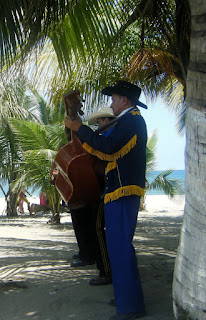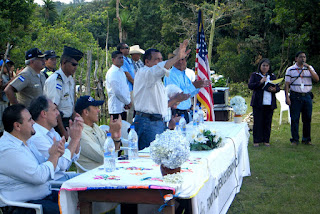We will miss Honduras, our wonderful fellow PCVs, the Peace Corps Staff, and the lovely Lencan people.
All the best to everyone.
Lauren & Jacob
 We marked off four 4 meter x 1 meter beds, and Jeff moved right into demonstrating the double-dig method. (You can read a basic description of Biointensive Agriculture here.)
We marked off four 4 meter x 1 meter beds, and Jeff moved right into demonstrating the double-dig method. (You can read a basic description of Biointensive Agriculture here.)
 But, the day wasn't without any setbacks. I knew that the spot we were using used to be the Health Center's backyard. They moved about 10 years ago to a larger building across town, but may have still been using the backyard to burn biohazard materials. Anyway, the image above is just a small portion of what we found in the soil. Some bottles were dated as late as 2003! (Welcome to the third world.) We carefully removed what we could while trying to avoid needles. Thankfully, the Health Center now uses receptacles for this sort of thing instead of burning or burying it all.
But, the day wasn't without any setbacks. I knew that the spot we were using used to be the Health Center's backyard. They moved about 10 years ago to a larger building across town, but may have still been using the backyard to burn biohazard materials. Anyway, the image above is just a small portion of what we found in the soil. Some bottles were dated as late as 2003! (Welcome to the third world.) We carefully removed what we could while trying to avoid needles. Thankfully, the Health Center now uses receptacles for this sort of thing instead of burning or burying it all. Unfortunately, with so many hazardous materials, we shut the gate so the children wouldn't enter. We originally wanted to let them help, kids love this stuff! But, we didn't want them potentially hurting themselves. Still, they got a good look at the seedlings and were very excited about having a garden.
Unfortunately, with so many hazardous materials, we shut the gate so the children wouldn't enter. We originally wanted to let them help, kids love this stuff! But, we didn't want them potentially hurting themselves. Still, they got a good look at the seedlings and were very excited about having a garden.  Once the beds were prepped, we started planting the 300+ seeds that germinated. We were able to take advantage of companion planting, and planted anywhere from 2 to 4 different kinds of seedlings in each 4x1 meter bed. The only pair that we had to really separate was onions and potatoes, so they are currently at opposite ends of the garden. One of the many advantages of this type of planting is that we can plant the seedlings closer together, most being anywhere from 20-40 cm apart. (Above) Jacob planting cabbage and cauliflower with the daycare Director.
Once the beds were prepped, we started planting the 300+ seeds that germinated. We were able to take advantage of companion planting, and planted anywhere from 2 to 4 different kinds of seedlings in each 4x1 meter bed. The only pair that we had to really separate was onions and potatoes, so they are currently at opposite ends of the garden. One of the many advantages of this type of planting is that we can plant the seedlings closer together, most being anywhere from 20-40 cm apart. (Above) Jacob planting cabbage and cauliflower with the daycare Director.
 While I was conducting research on the best way to prepare and plant potatoes, I got fed up with the variety of answers. So, I called up my grandfather, who has been planting potatoes for much longer than I can remember. Some of my best childhood memories are helping dig up potatoes with him and my great uncles. I think he was thrilled that I called, and he gave me some great advice. And, with the double dig method, you can plant them as you dig, saving a lot of time in the process.
While I was conducting research on the best way to prepare and plant potatoes, I got fed up with the variety of answers. So, I called up my grandfather, who has been planting potatoes for much longer than I can remember. Some of my best childhood memories are helping dig up potatoes with him and my great uncles. I think he was thrilled that I called, and he gave me some great advice. And, with the double dig method, you can plant them as you dig, saving a lot of time in the process.

 The Director of the daycare at left and staff member at right working on the abonera.
The Director of the daycare at left and staff member at right working on the abonera. I purchased a plastic seed bed holding 200 seeds for my personal use, but decided to break it in using seeds for the local daycare. A plastic seed bed costs roughly 75 Lempiras ($3.96) and is too costly for many here to purchase. So, we gathered up some empty (and free!) egg cartons from around town and are using these as well. Each carton holds 30 eggs, so with 5 cartons we added another 150 seeds to be planted.
I purchased a plastic seed bed holding 200 seeds for my personal use, but decided to break it in using seeds for the local daycare. A plastic seed bed costs roughly 75 Lempiras ($3.96) and is too costly for many here to purchase. So, we gathered up some empty (and free!) egg cartons from around town and are using these as well. Each carton holds 30 eggs, so with 5 cartons we added another 150 seeds to be planted. Because Jacob and I travel for business/health presentations and trainings, we made a green house to retain moisture, etc... when Jacob and I are away from site. It's our first green house, don't be too harsh :) The staff decided it was best to leave the seedlings at our house, so 50 little hands could get into them, lol.
Because Jacob and I travel for business/health presentations and trainings, we made a green house to retain moisture, etc... when Jacob and I are away from site. It's our first green house, don't be too harsh :) The staff decided it was best to leave the seedlings at our house, so 50 little hands could get into them, lol.












 During dinner we all simultaneously discovered that no one at site invites us couples to anything... weddings, fiestas, birthdays, or even lunch. People in all of our sites seem to assume that we have our own daily agendas and can't be bothered. Our single volunteer friends all tell us of the crazy fiestas they've been to, and Jacob and I kept thinking maybe the locals didn't like us too much. But, at least now we hope it's just because we're married, and I need to be at home to cook my husband's breakfast/lunch/dinner/wash his clothes.... you name it.
During dinner we all simultaneously discovered that no one at site invites us couples to anything... weddings, fiestas, birthdays, or even lunch. People in all of our sites seem to assume that we have our own daily agendas and can't be bothered. Our single volunteer friends all tell us of the crazy fiestas they've been to, and Jacob and I kept thinking maybe the locals didn't like us too much. But, at least now we hope it's just because we're married, and I need to be at home to cook my husband's breakfast/lunch/dinner/wash his clothes.... you name it.





 I can't wait to have my first miso soup in 5 mths! A side note, I found a good recipe for tofu that I plan to try with my schmorgasborg of Japanese ingredients: Quick and Easy One Hour Tofu — La Fuji Mama
I can't wait to have my first miso soup in 5 mths! A side note, I found a good recipe for tofu that I plan to try with my schmorgasborg of Japanese ingredients: Quick and Easy One Hour Tofu — La Fuji Mama


